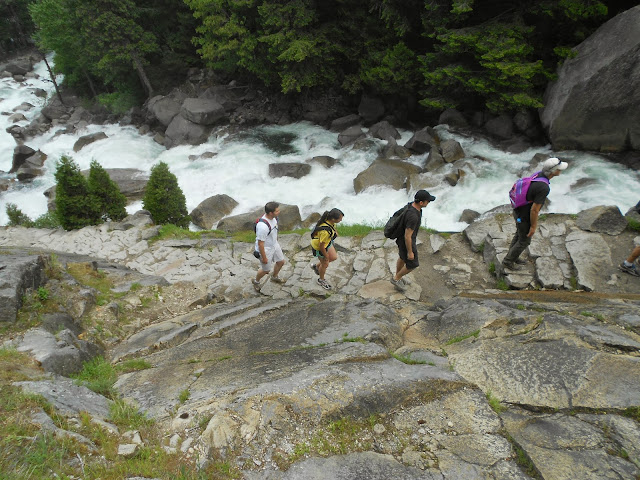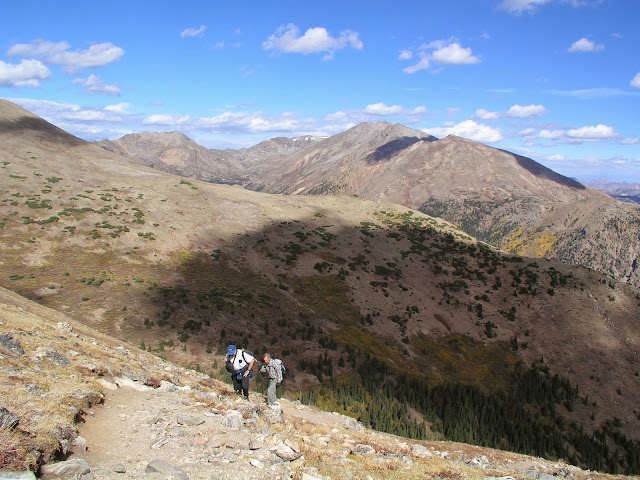All photos by Ravell Call
Hiking Humphreys Peak, the highest point in Arizona, is actually ascending the remains of a dormant stratovolcano that dominates the high desert landscape in the Flagstaff region.
At 12,633 feet above sea level, Humphreys is a nine-mile round-trip hike that climbs 3,200 feet from the Arizona Snowbowl ski resort's lower parking lot, in the Kachina Wilderness region of the Coconino National Forest.
The peak rises some 5,700 feet above Flagstaff, though Humphreys is not visible from all but a small slice of the southeastern part of town. That's because neighboring Agassiz Peak (elevation 12,356 feet) obscures Humphreys from the majority of Flagstaff.
Scaling Humphreys' upper reaches is a lot like hiking Mount St. Helen's in Washington; wooden poles mark the path through lots of loose volcanic rock.
"This is amazing that Arizona can have such a rugged mountain," Marilyn Sanders, another Calgary resident, said."I think it looks like you are on top of the world," said Phil Rosso of Calgary, Alberta, Canada, after reaching the Humphreys summit in late morning.
"The hike was OK, a little tricky at the top," Jackie Hester, from Carpinteria, Calif., said after reaching the Humphreys summit.
She was also impressed by the clear skies and no wind — a rarity on the usually blustery summit.
"Spectacular views, very windy," was what Mike Vuk recorded in the summit's log book.
"It's windy. I bet everyone writes that," Robert Conly wrote in the log.
"Praise God for his awesome creation," is what Keith Wegehaupt wrote in the summit log.Roy Major from Tempe, Ariz., wrote that he had scattered his son's ashes on the peak in accordance with his last wishes.
Adam Schafer penned this: "Awesome hike. I am beat! Where's the hammock?"
Humphreys is best hiked in late summer or early fall (June to October), when there is no snow. The shortest starting point is the Snowbowl's lower parking lot, at 9,500 feet above sea level. The resort is about 14.5 miles from Flagstaff.
There is a restroom but no water available at the trailhead.
The current trail was built in 1984.The U.S. Forest Service states that the hike is a strenuous one, with moderate to heavy use. The hike requires three hours to the summit along a steep path through "a thriving alpine forest streaked with huge rock slides and avalanche tracks hug the mountain's slopes."
The Forest Service report continues: "As the elevation increases, trail-side vegetation shows more and more evidence of the extreme harshness of this environment. Near tree line, what's left of the forest consists entirely of bristlecone pines bent and twisted by wind and frost. This hardy tree manages to live one of the longest lives on earth in one of the planet's most inhospitable environments.
The trail is well-marked in the early stages. After crossing a meadow under the ski lift, the trail goes through a dense forest with plenty of shade. However, after two miles, it crosses an elevation of 11,400 feet, just below the timber line."Above tree line, the only plants that can survive are small tundra shrubs and wildflowers that huddle for shelter among the rocks. Some are found nowhere else in the world. Overhead, above Arizona's highest ridge, white-throated swifts dive and flash like miniature fighter planes as they feed on nearly invisible insects borne on the wind."
No mechanized or motorized vehicles, including bicycles, are allowed along the trail. There is no hiking off-trail above the tree line or camping, in order to protect the San Francisco Peaks Groundsel, a plant found nowhere else in the world.
For this reason, it is also not legal to use the Snowbowl ski lift to hike Humphreys, since you have to go off trail.
Backcountry permits are required in the winter here.
Ski poles may be helpful for older hikers in the trail's upper reaches of loose rock and soil.
On top, there is a panoramic view that includes the distant Grand Canyon on a clear day. Many expanses containing volcanic cones are also readily visible. A circular pile of rocks has been built at the summit for a measure of protection against the usual winds there.
Hikers need to be cautious of incoming thunderstorms, especially in the afternoon, as lightning is the main hazard above 12,000 feet.
Humphreys is part of the San Francisco Mountains, the remains of a 15,000-foot volcano that existed here 200,000 or more years ago, until it exploded and/or collapsed. It is believed to have had a pyramid shape and looked a lot like Japan's Mount Fuji.
The huge volcano's cataclysm left the five major peaks visible on the mountainside today. These San Francisco Peaks are sacred to 13 Native American tribes in the region.
So great is Indian reverence for the peaks that some tribes recently took court action to block an attempt to use reclaimed water on the mountain to create snow for the Snowbowl resort. The Native Americans wanted pure water used on the sacred slopes.
The Hopi Indians called the mountains "Nuva'tuk-iya-ovi," or "place of high snows."
In contrast, early Spanish explorers called the San Francisco Mountains originally "Sierra Sin Agua," or "mountains without water," because of the absence of any rivers flowing off the mountains.
Humphreys was named after General Andrew A. Humphreys (1810-83), who was chief of the U.S. Corps of Engineers from 1866-79.
The wilderness around Humphreys is the only alpine tundra environment that Arizona has.
Eleven other states have high points that exceed Humphreys in height. Utah's Kings Peak, at 13,528 feet, is one of them. For overall difficulty of climb, the Highpointer's Club (America'sroof.com) ranks Humphreys as the 10th hardest, behind Colorado's Mount Elbert. Utah's Kings Peak is seventh toughest.
--If you go
To hike Humphreys Peak from Flagstaff, drive north on U.S. 180 for seven miles to Forest Road 516, the Snowbowl Road. Drive 7.4 miles on this paved road to the lower parking lot of the Snowbowl facility. The trailhead is located at the north end of the parking lot.
For more information, contact Peaks Ranger Station; 5075 N. Highway 89; Flagstaff, AZ 86004; or call 928-526-0866.
For additional information on hiking Humphreys, consult "Highpoints of the United States," by Don W. Holmes, or "Highpoint Adventures," by Charlie and Diane Winger.
(-Originally written by Lynn Arave in the Deseret News.)
































